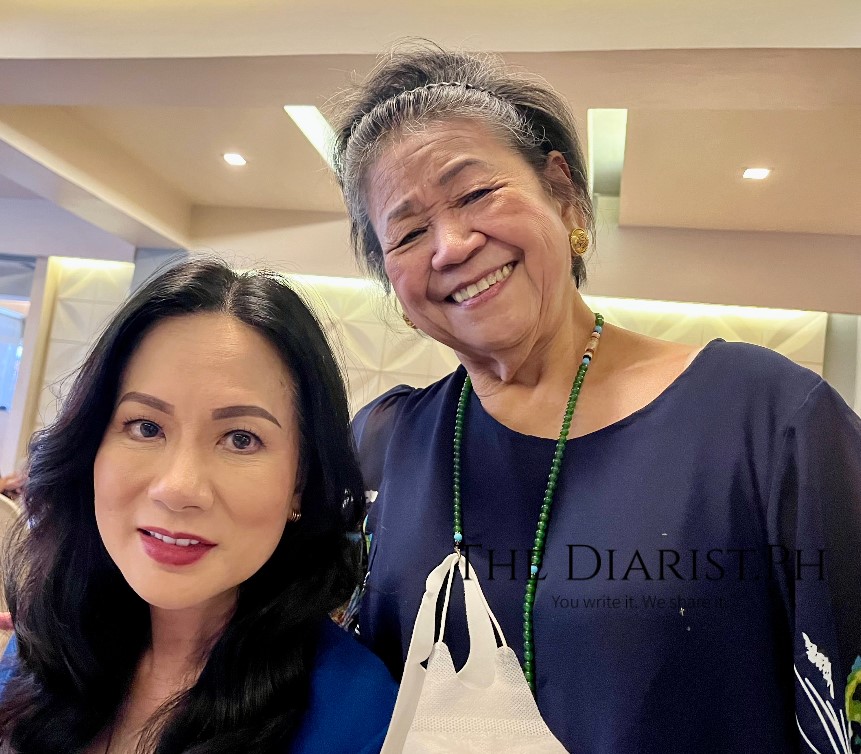
The softly lit old sacristy of San Bartolome Church before the chamber music concert (Photo by Thelma Sioson)
When I received the invite from Monchet Lucas to come to Malabon and watch a concert at San Bartolome Church, I knew I simply had to go, no matter the distance. Not only would it be a coming home for me; it would also be a retrieval of memory. My good friend, Carlson Chan, who relayed the invite, knew it would be a trip I couldn’t resist.
I grew up in Malabon, where my father was from and which gave me childhood preferences for kutsinta, sapin-sapin, my paternal grandaunt’s adobo, and of course, pancit Malabon, which my mother had mastered for her young family. My mother continued to cook pancit Malabon for us way into her twilight years; she passed on the recipe (complete with oysters, shrimps, chicharon, and tinapa flakes) to our trusted yaya and cook who, sadly, had long retired back in her province. Now, if I want a filling pancit Malabon, complete with squid and crushed chicharon, and want it accessible to me, I go to the stall at South Supermarket in Alabang.
Carlson said that our lunch before the concert would be at Betsy’s Cake Center across from San Bartolome church, to be hosted by Betsy herself, the daughter of the Malabon-born famous painter, Serafin Serna. That became another reason for looking forward to a Malabon homecoming.
I remember how we would spend Saturday mornings around the town plaza at San Bartolome Church, cooped up in our parked car, with Daddy keeping me and my younger brother away from boredom as we waited for Mommy do her wet marketing. In those days mothers did wet markets and would have nothing less than fresh seafoods and meats for their daily cooking. Mommy never dropped the habit—decades later, even after we had moved out of Malabon to the south, she’d go, with alarming frequency (to us), to the wet market for fresh oysters and seafood, this time in her hometown—all the way in Obando, the coastal town in Bulacan that was near Malabon. (My loyalties in childhood were divided between Malabon and Obando.)
We would go to morning Sunday Mass at San Bartolome Church, where, each time, I’d always remind my younger brother to make sure not to stand close to the massive church columns, or to make sure to walk a distance away from them—because, if you read closely, I’d tell him, there are names on the columns and those are of the dead buried there. My younger brother would be dutifully scared and behave during Mass. As early as our preschool years, I knew how the power of fear could reduce one into submission.
Today the Skyway 3 (part of the infrastructure born during PNoy’s time, let’s be clear about that) has made the drive to Malabon quite easy. We got to Betsy’s Cake Center in time for lunch. The broas and the eggpie in the cake counter pointed out to me by Carlson as soon as we entered the restaurant brought me the joy of nostalgia—mine was the eggpie generation, way before the tiramisu generation.
Upstairs, Betsy David prepared a buffet feast no Malabon native could resist: pancit Malabon like no other outside of Malabon (from the sauce to the squid and other ingredients), among other pancit, pork liempo on rice, adobo, black kutsinta (from Caloocan, I was told), among others. The Malabon tastebud (at least mine and Daddy’s) is partial to salty—salty fresh; my dad would drizzle even his sweet mango with patis. Through the generations, Malabon has been known for patis—Malabon fish sauce that’s fresh-tasting, not assaulting. It is synonymous with Rufina Patis, now a heritage brand.

Pancit Malabon in Betsy’s buffet

At lunch at Betsy’s, from left, Carlson Chan, Thelma Sioson, NCCA chair Ino Manalo, Betsy David, architect Richard Tuason-Sanchez Bautista
- Malabon Mayor Jeannie Sandoval (left) and Betsy David at lunch at Betsy’s Cake Center (Photo by Thelma Sioson)
- Raffy Camus
Atty. Monchet Lucas and his siblings Jerry and Pilar, of the family behind this brand, with Betsy, entertained the guests at lunch, and later in the concert, guests led by NCCA chair Ino Manalo, Malabon mayor Jeannie Sandoval, and cultural heritage architect Richard Tuason-Sanchez Bautista. Mayor Sandoval told me that Malabon is being primed more and more as a destination, for local and foreign tourists, not only for its food but also for its heritage homes and local festivities. It matters that its occasional flooding has been greatly alleviated—the installation of pump infrastructure makes the water subside fast.
I was surprised to see the San Bartolome Church of today. Its façade and interior are more opulent and more visually loaded than what I remember—elaborate frescoes, bold colors, majestic dome. The San Bartolome of my childhood was not at all visual in my memory; it was a non-color—cream or sepia, if ever.

Facade of the restored San Bartolome Church without the patina of age (Photo by Thelma Sioson)

San Bartolome Church today

Side view of San Bartolome Church (Photo by Thelma Sioson)
The San Bartolome church in Malabon became a parish in 1614, its stone structure built in 1622, its façade and two bell towers built in 1896, around the time of the Cry of Pugadlawin, which, the church marker says, Andres Bonifacio timed with the Feast of San Bartolome (August 24). The religious feast was used as cover-up gathering by the Katipuneros. Until I read this marker on this visit, I didn’t know the place in Philippine history of San Bartolome Church.

San Bartolome Church marker details its history. (Photo by Thelma Sioson)
We walked to the back of the church and there, we entered the old sacristy that has been restored in recent years. What a discovery for a truant Malabon native like me.
The stone-walled sacristy, given its compact space, is perfect for chamber music, we would find out. The acoustics is suited to an intimate chamber music performance; the sound envelops you, not assaults you.
The main experience of our Malabon homecoming was the Schubert’s Trout Quintet and Others…, the afternoon concert featuring Mariel Ilusorio on the piano, Coi Reyes on the viola, Noel Martin on the violin, Steven Retallick on the cello, Aris Payte on double bass.

Chamber music artists, from left, Noel Martin, Mariel Ilusorio, Coi Reyes, Aris Payte and Steven Rellick (far right) acknowledge applause, with Fr. Paul Nicklaus Woo (second from left) and special guest, Bishop Pablo Virgilio David (third from left)

Mariel Ilusorio (left) explaining the ‘Schubert’s Trout’ right before performance; Fr. Paul Nicklaus Woo welcoming guests to old sacristy (Photo by Thelma Sioson)

Bishop Pablo Virgilio David and Atty. Monchet Lucas in ‘Schubert’s Trout Quintet….’ chamber music concert at San Bartolome old sacristy

The author with, from left, Atty. Monchet Lucas, NCCA chair Ino Manalo, Carlson Chan

Atty. Monchet, Jerry and Pilar Lucas
Pianist Ilusorio has been bringing classical music to select audiences in the country, such as at Baguio Country Club recently. Our appreciation of her virtuosity on the piano is enhanced by her ability to communicate with her audience up close, her words just as lucid and engrossing as her performance. A storyteller, she described Schubert’s story of the trout in the waters, its movements putting you in great anticipation of the music you were about to share. The old sacristy space and Ilusorio’s articulateness, both as pianist and program host, were perfect for the confined sharing that is chamber music.
Reyes, who’s familiar among online listeners especially during the pandemic (Metro Music Strings), started the program with Bach Prelude from Suite No. 2 in D Minor for solo viola. This was followed by Rachmaninoff Cello Sonata Third Movement by Retallick, whose considerable orchestra experience has brought him from Europe to Asia.
Noel Martin, the American violinist, has been performing, teaching, and coaching in the US, Central America and Asia. He has even taught in outreach programs for children in the Philippines. He teaches violin at the UST Conservatory of Music.
The ensemble performed Schubert Trout in A Major (Allegro vivace, Andante, Scherzo Presto, Andantino-Allegretto, Allegro Gusto) before an audience immersed in the experience, eager to savor the nuances of the piece.
The ensemble received an ovation from the gathering of about 70 music lovers, many of them coming from outside Malabon. It did an encore, Silent Night, Holy Night, putting the gathering in the mood for Christmas which, in the setting of an old sacristy, became one of pious nostalgia.
The concert was staged under the auspices of the Roman Catholic Bishop of Kalookan Diocesan Archives and Museum, the Committee on Cultural Heritage of the Church.
Bishop Pablo Virgilio David, Fr. Paul Nicklaus Woo gave the bouquet of appreciation. Bishop David gave the closing remarks.
The chamber music performance at the old sacristy is held every quarter. The next is in February next year.
It was getting dark as we left the sacristy. We walked briefly past the front of the old San Bartolome Catholic Cemetery. The feeling reminded me of a dream I once had many years ago—a story for another day.








